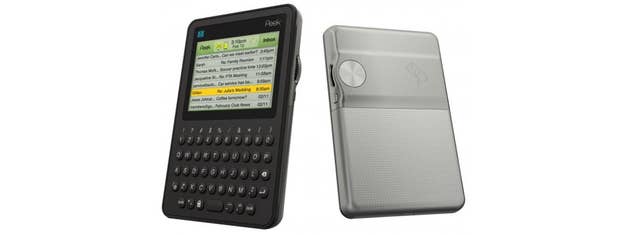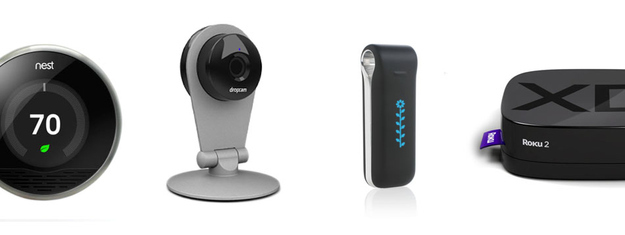
Imagine you had had $10 million to invest in 2007, when the Facebook IPO was just a twinkle in Mark Zuckerberg’s eye. Would you have bought Apple stock? Or finagled your way into some kind of private investment with Facebook? Or just bet against the soon-to-collapse world economy and put your money in a box? Amol Sarva did something else: He invested in a gadget startup. It was called Peek.
Peek made a BlackBerry-style device that only sent emails. The pitch was pretty good, and novel: Instead of dropping a few hundred bucks on a smartphone and signing up for a two-year contract, you could just supplement your flip phone with a $70 device that sorta did the same thing. Low fees, no contracts, decent hardware.
The first Peek was named gadget of the year by Time and Wired magazines, and got mostly positive reviews. They even sold a alot - Sarva hinted to me that they got to about 100,000 users. Things were going well. "We sold a bunch, and got into big retail channels," Sarva told me. "But we couldn't keep up that growth without more money." If he could do it all again, though, Sarva says he would have done things a little differently: “I would have invested in Twitter.”

That’s why the next iPad or iPhone won't come from a startup. It will come from Apple, or a company like Apple. It will come from a big boring company with a multi-billion dollar R&D budget and thousand of engineers. A modern-day Steve and Woz wouldn't be building computers in a garage and begging for deals with local stores. They’re building apps and angling tweets at venture capitalists.
Investors love software startups for two reasons: They don't cost much to run, and if they blow up, they blow up big. Gathering users is cheap and easy — usually you're giving something away for free, at least at first — and overhead is low. If it doesn't work, well, who cares? It was worth it. It could have been huge.
Hardware startups are nothing like that. A successful hardware business is one that grows briskly and makes money. Not a ton, at first – just enough to grow some more. The same applies to companies with big upfront investments, like mobile carriers. "AT&T and Verizon spend $300 to $400 to acquire a contract customer," said Sarva. "Our 'breakthrough' was getting people for $50."
These prices don't drop. Getting that first 100,000 users was great, and getting the next 100,000 was probably going to be a little easier. But it wasn't going to be much cheaper, which meant Peek needed more investment — probably about $50 million more, said Sarva, which is a lot to ask of VCs even when you're not in the middle of a terrifying global recession. Those 100,000 customers paying for service are nice to have, but they won't pay for 100,000 more devices, or a national marketing campaign, or dozens of salesmen.
This is almost the exact situation that streaming TV box company Roku is in right now: They need $50 million for “expansion,” and they’re going to have a hard time getting it. They’re popular and they sell a great thing, but they’re losing money. They’re asking TV companies for help - they’re not expecting anything from VCs.
Like Roku, Peek had been working, but Sarva knew the money wasn't going to come. The company quickly (and smartly) switched from hardware to software — something called Genius Cloud, which aimed at giving low-end, developing market smartphones cloud services — and that's where he'll stay. As of February 1st of this year, every Peek device has gone dark.
***
Last year 45 tech companies when public, together valued at about $75 billion. More than half of the money raised by those IPOs went to internet and digital media companies like Pandora, LinkedIn and Groupon. The best performing, as judged by the market, were three software companies you've probably never heard of: Tangoe, Service Source, and Imperva. There were a handful of IT companies, some hardware component companies, some medical tech and cleantech companies, and one of whatever you'd call Zipcar. What there wasn't: a gadget company.
At least the Peek was a new idea. In 2007 it wasn't quite as clear as it is today that all-purpose smartphones would be so popular, and for a few years there really were tens of millions of possible Peeksters: People who saw the appeal of a smartphone — email in your pocket! — but weren't ready to make the jump.
Every other buzzy hardware startup — there aren't many — thinks they've found something new, too: Nest has the first well-designed "learning" thermostat; Dropcam's zero-config wireless camera is much easier to use than similar gear from much larger companies. These startups want to, or rather have to, basically invent a whole new category — then own it. This guarantees two things: That your product at least has the potential to be huge, and that you won't be competing against a company like Apple or Microsoft. Not at first, at least.

In the last three months, Apple has spent three quarters of a billion dollars on R&D, much of which was likely spent on the iPhone and iPad. Samsung is spending about $2.3 billion a quarter, and Sony's burning through a billion. Microsoft spent $2.4 billion on developing its dozens of hardware and software products over the same period. Based on the huge revenue and weirdly low profits of its Entertainment and Devices division, the part of the company responsible for Xbox and Windows Phone, it's safe to say that Microsoft is spending hundreds and hundreds of millions to make sure its newer gadgets succeed no matter what. It took years of bleeding for Microsoft to compete with the Playstation, and it'll take just as much, if not more, for Microsoft and its team of hardware partners to make Windows Phone a thing, and even then there's no guarantee that it'll work. Microsoft tried to make people buy Zunes for five years, remember?
Smart startups don’t try to compete with behemoths. Dumb startups sometimes do. Fusion Garage was the company contracted to design and build the CrunchPad tablet in 2009, which, after ages in “development” and and embarrassing and public meltdown with the project’s, founder, Michael Arrington, came to market as the hideous and overpriced JooJoo. (Like, just in time to compete with the iPad.) The company’s followups, the conceptually interesting but dangerously undercooked Grid 4 smartphone and Grid 10 tablet, got a bit of attention before the company, which had probably shipped no more than a few hundred units of anything, ever, collapsed under $40 million in debt.
Microsoft can afford to do this right. So can Apple, Samsung, LG, HTC and Sony. But some startup? Not a chance. When it comes to hardware, young geniuses need not apply. The line for Code Academy starts over here.
